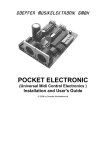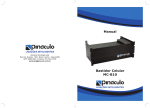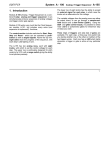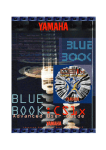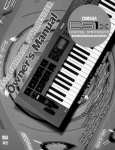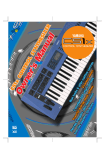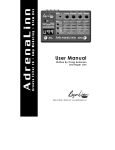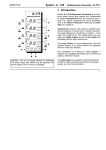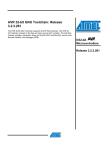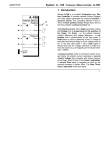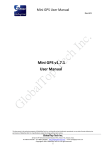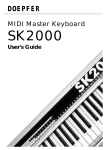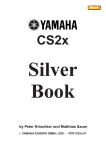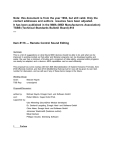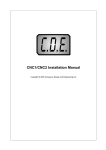Download A-192
Transcript
doepfer System A - 100 CVM 16 A-192 1. Introduction Module A-192 is a CV-to-MIDI interface that converts 16 control voltages in the range 0...+5V into 16 MIDI control change messages. A-192 is the modular version of Pocket Control with the 16 rotary controls replaced by 16 miniature jack sockets to process any control voltage instead of the manually generated MIDI control changes of Pocket Control. MIDI messages appearing the MIDI Input are merged to the MIDI controller messages generated by the A-192. 128 different assignments (Presets) of the 16 CV inputs to MIDI controller messages are available. Switching between the 128 presets takes place with an 8-pin DIP switch on the pc board (permanently) or via incoming MIDI program change messages (temporarily). If none of the 128 factory presets is suitable new presets can be programmed with the Pocket Control editor program which is available for free on our web site www.doepfer.com. The snapshot button transmits the 16 momentary states of the 16 inputs as MIDI controller messages. 1 A-192 CVM 16 System A - 100 Controls and indicators 2. Overview 1 Snapshot : Momentary switch (sends a snapshot of all the momentary CV settings) A-192 CVM16 CV-to-MIDI Interface 1 2 3 4 ! 2 Control: 9 Snapshot 1 Control 2 LED display (- DIP switch: 8 pin switch on the A-192 pc board to select a preset, not shown) 10 In- / Outputs: 11 12 5 13 6 14 7 15 8 16 DOEPFER 2 doepfer MIDI In " MIDI Out § ! Sockets : 16 CV inputs (range 0...+5V) " MIDI In : MIDI input § MIDI Out : MIDI output doepfer System A - 100 3. Basics Module A-192 converts up to 16 analog control voltages (CV) in the voltage range 0...+5V into 16 MIDI controllers (exactly: MIDI control change messages). The MIDI channel for each controller can be selected (1-16). E.g. 16 different controllers on the same MIDI channel may be chosen, or even the same controller number on different MIDI channels. All mixtures of controller numbers and MIDI channels are possible. The term controller is not quite correct as A-192 even supports similar messages like after touch or pitch bend, as well as most of the common RPN resp. NRPN controllers and most of the GS, XG controllers resp. XG sysex messages. The active input voltage range is 0...+5V. Negative voltages and voltages above +5V are not converted. A protection circuit on each input prevents the damage of the module as long as the voltages applied to the inputs are in the range of -12V...+12V. This means that within the A-100 system it is not possible to damage the A-192 module as the output voltages of all A-100 modules are within these limits. If negative voltages (e.g. from a LFO) or voltages above +5V (e.g. from an ADSR) are to be converted an attenuator / offset generator module (A-129/3) has CVM 16 A-192 to be inserted between the voltage and the A-192 input. The A-129/3 enables the addition of a positive voltage and the attenuation of the input voltage so that the output (= input of A-192) is in the required range of 0...+5V. The assignments of the 16 CV inputs to MIDI controllers and channels is defined in 128 presets. A preset is selected permanently with an 8-pin DIP switch on the pc board or temporarily via incoming MIDI program change messages on the MIDI master channel. You will find a table of all factory presets with the corresponding DIP switch settings in the appendix of this manual. If none of the factory presets is suitable for your application you may program one or more new presets with the editor program which is available for free on our web site www.doepfer.com. (same as editor program for Pocket Control). The program runs on a PC under Windows 95/98/2000. For a small extra charge (about US$10.00) we also have available the OEM version of Emagic’s Sounddiver (universal editor program) suitable for both PC and Mac. 3 A-192 CVM 16 System A - 100 doepfer As soon as one of the 16 input CVs changes the corresponding MIDI controller messages is generated. In case of a continually changing voltage (e.g. from a LFO or Theremin) the corresponding MIDI controller is transmitted permanently. In case of a static voltage (e.g. from CV source A-176) the single transmission of all 16 MIDI controllers can be triggered with the snapshot button. 4. Controls and indicators Unused inputs are connected to GND (= 0V) by means of the switching contacts of the CV sockets (sockets are “normalled to GND”). This means that an unused input will generate no MIDI data as long as no plug is inserted into the corresponding CV socket (and the snapshot button is not operated). Please avoid to connect a patch cord into a CV socket with the second side left open. In this case the switching contact does no longer connect the CV input to GND and random MIDI data are generated for this CV input. The switch is a remnant of Pocket Control which is equipped with 16 (static) rotary potentiometers. The switch is normally not required for A-192 operation. Especially the snapshot function (item 1 in the list above) is normally not necessary because the input voltages of A-192 usually change permanenty and thus the MIDI data are generated permanently. The 16 analog inputs are internally converted into digital data by means of an 8-bit analog-to-digital converter (ADC). Because of the MIDI data format only 7 bits are used (MIDI data range 0...127). 4 1 Snapshot The Snapshot switch has various functions: • to send a Snapshot of all the current CV settings • for setting the master MIDI channel • to reset the A-192 after an overflow at the MIDI in Generating a Snapshot: The snapshot function is not achieved by just pressing the snapshot switch, as this could be accidentally pressed too easily. So to activate the Snapshot function, first briefly press the Snapshot switch once, this causes the LED to flash, the Snapshot switch needs to be pressed again within at least one second (whilst the LED is still flashing). This then invokes the snapshot function, and the data from all 16 control knobs is transmitted from the A-192. doepfer System A - 100 The snapshot switch may even be used to set the MIDI master channel. This is not as simple as for Pocket Control because of the missing 16 potentiometers (remember: the switch is a remnant of Pocket Control): To set the Master channel, hold the snapshot switch down for at least one second and keep it held down, the LED then stays on to indicate Master channel setting mode (do not let go of the button until the required value has been selected). In this mode the CV inputs become channel selectors, and do not transmit the normal control data. To select a channel, the input voltage change on one input is necessary while the other 15 voltages remain unchanged (e.g. to set channel 5, the voltage of CV input 5 has to be changed). If you accidentally changed the wrong voltage, just change the correct one, as it is the last voltage change that determines the actual Master channel set. In practice all plugs are removed except the one plug that defines the MIDI master channel. On this plug now a changing voltage has to appear. The master channel is stored non-volatile in the module even during power off. We know that this way of setting the master channel is not very comfortable but this function is a remnant of Pocket Control. In practice this step has to be carried out only once and is not necessary if the editor program is used. CVM 16 A-192 To clear any MIDI input error such as a MIDI overflow (too much data in one go), press the snapshot switch briefly once (do not press it again until at least one second has passed, or this would enter the snapshot mode). For details please refer to the next chapter. 2 Control The LED 2 indicates the status in various modes. Under normal operation the LED indicates MIDI input activity, and also MIDI output activity when input voltages are converted into MIDI data. The LED also indicates: • Power on reset - the LED will stay lit for around one second when the power is first applied. • Any error at the MIDI input (MIDI overflow) - the LED turns on permanently • Data and status when setting the Master channel (see 1 snapshot) • The status of the Snapshot function (see 1 snapshot) • Indication that a preset has been changed Typical reasons for a MIDI overflow are too much MIDI data (e.g. MIDI output of a computer sequencer with many active tracks/channels) or Sysex data sent too fast to the module. In both cases wrong MIDI data may be sent to the MIDI output of the module. 5 A-192 CVM 16 System A - 100 5. In- / Outputs ! CV Inputs 1 ... 16 The 16 sockets ! are the control voltage inputs of the CV-to-MIDI interface. The control voltages to be converted into MIDI data are connected to these sockets. The active voltage range for each input is 0...+5V. 0V corresponds to MIDI data 0, +5V to 127. The conversion is linear (i.e. +2.5V corresponds to about 63/64 MIDI data). The module is working reliable as long as the input voltages are within the limits 5V...+12V but only the range 0...+5V is converted into MIDI data. Voltages less than -5V may cause faulty MIDI data. The protection circuit on each input prevents a damage of the module as long as the voltages applied to the inputs are in the range of -12V...+12V. Voltages more than +12V or less than -12V may damage the module. Within the A-100 system it is not possible to damage the module as no voltages beyond these limits are generated within the A-100 system. An attenuator/offset module A-129/3 should be used to convert voltages beyond the range 0...+5V into the active range 0...+5V. 6 doepfer " MIDI In The MIDI In socket " has 3 different functions: • MIDI data from another MIDI device may be transmitted to the A-192 and merged with the MIDI data generated by the A-192 (e.g. the MIDI output of a keyboard). • The MIDI input is required if an editor program is used to change presets in the A-192 or to progam new ones. Please refer to the manual of the editor program for details. An editor program for PC is available for free download on our web site www.doepfer.com (same as Pocket Control editor). • An incoming program change message on the MIDI master channel selects one of the 128 presets. This selection is only temporarily, i.e. the new preset is active only until the next power off. During power on the preset defined by the DIP switch setting is selected. The selection of a new preset via program change is indicated by lighting up of the LED for about one second. During this period no incoming MIDI data is recognized (i.e. no MIDI merging, no program change recognition). If none of these applications is used the MIDI in socket remains unconnected. doepfer System A - 100 § MIDI Out This is the MIDI Out socket. It is connected to the MIDI input of the device controlled by the MIDI data of the A-192 (e.g. computer sequencer, expander, keyboard, MIDI-toCV converter and so on). 6. User Examples Module A-192 can be used to convert any control voltage in the A-100 into MIDI controllers. Especially those applications normally not available in the world of MIDI are the most interesting ones. Of course one may convert a (slowly oscillating) LFO or ADSR into MIDI. But more interesting are e.g. those applications: • • • • • Theremin-to-MIDI (A-178 ➔ A-192) Light-to-MIDI (A-179 ➔ A-192) Envelope-to-MIDI (A-119 Envelope ➔ A-192) Sequencer-to-MIDI (A-155 ➔ A-192) Footcontroller-to-MIDI (A-177 ➔ A-192) Vocoder MIDI interface CVM 16 A-192 129/1 is connected to the A-192 inputs. The A-192 converts the 15 analysis voltages into 15 MIDI controllers. The 16th input may be used for voiced/unvoiced control or as control voltage for the slew limiter. The MIDI data generated by the A-192 may be recorded and stored with a computer sequencer. Dependent on the power of the sequencer different possibilities are coming up: • Recording and playing back the recorded “vocoder sequence” (MIDI controllers) at different at speeds • “Freezing” at a certain position (e.g. a vowel like “a”) • Storing certain vowels or filter settings • Realtime display of the controllers like a spectrum analyser The conversion of the recorded MIDI controllers back into control voltages may be performed with a special version of the MIDI-to-CV converter A-191. A modified version that responds to 16 MIDI controllers is required (i.e. without LFO, after touch and pitch bend). The first 15 CV outputs are connected to the CV inputs of the vocoder synthesis section A-129/2. The 16th CV output may be used for voiced/invoiced control (i.e. controlling a VC switch) or as control voltage for the slew limiter controller A-129/4. Another very important application of the A-192 is the “MIDI-fication” of the vocoder modules A-129/x. For this the outputs of the vocoder analysis module A7 A-192 CVM 16 System A - 100 7. Patch-Sheet The following diagrams of the module can help you recall your own Patches. They’re designed so that a complete 19” rack of modules will fit onto an A4 sheet of paper. Photocopy this page, and cut out the pictures of this and your other modules. You can then stick them onto another piece of paper, and create a diagram of your own system. doepfer A-192 CVM16 CV-to-MIDI Interface 1 9 Snapshot 2 10 Control 3 11 4 12 Make multiple copies of your composite diagram, and use them for remembering good patches and set-ups. 5 13 P 6 14 7 15 8 16 • Draw in patchleads with colored pens. • Draw or write control settings in the little white circles. DOEPFER 8 MIDI In MIDI Out doepfer System A - 100 Appendix: Selecting a Preset with the DIP switch On the A-192 main board an DIP switch with 8 single switches is located near the LED behind the sockets no. 10 and 11. This switch is used to select one of the 128 presets after power on. As 8 switches could address 256 presets the eighth switch is unused. Its setting has no meaning so far. The least significant switch (labelled “1” in the table on the following page) is located below in direction to the MIDI sockets. The most significant switch (labelled “8” in the table) is located above near the LED. A closed switch (position “ON”) corresponds to a “1” in the table on the following page. An open switch (position “OFF”) corresponds to “0”. CVM 16 A-192 The term Masterchn means that the MIDI data are transmitted on the MIDI master channel (see page 5 concerning the master channel). More detailed information about the presets you may find on our web site www.doepfer.com in the product description and user’s manual of Pocket Control. In this manual the presets are described a little bit more detailed. A-192 is identical to Pocket Control if one replaces the 16 rotary potentiometers (generating 0...+5V) by the 16 input sockets of A-192 in the product description and user’s manual. For the A-192 probably one of the more general presets 0...15 is the best choice. E.g. presets no. 8 (MIDI controllers 0...15 on the master channel) or preset no. 9 (MIDI controllers 16...31 on the master channel). The empty presets from no. 65 are not used while this manual is written. But they may be in use when you receive the module. On our web site www.doepfer.com you will find the current state of all presets (same as for Pocket Control). Additionally a preset can be selected temporarily with a MIDI program change message on the master channel (see chapter 5 / MIDI In). 9 A-192 CVM 16 12345678 00000000 10000000 01000000 11000000 00100000 10100000 01100000 11100000 00010000 10010000 01010000 11010000 00110000 10110000 01110000 11110000 00001000 10001000 01001000 11001000 00101000 10101000 01101000 11101000 00011000 10011000 01011000 11011000 00111000 10111000 01111000 11111000 10 System A - 100 Preset #: preset name Preset 0: Volume Channel 1 - 16 Preset 1: Panorama Channel 1-16 Preset 2: Cutoff Channel 1-16 Preset 3: Resonance Chan. 1-16 Preset 4: Volume/Pan Ch.1 - 8 Preset 5: Volume/Pan Ch.9 - 16 Preset 6: Cutoff/Reson. Ch.1-8 Preset 7: Cutoff/Reson. Ch.9-16 Preset 8: Ctrl 0-15 Masterchn Preset 9: Ctrl 16-31 Masterchn Preset 10: Ctrl 32-47 Masterchn Preset 11: Ctrl 48-63 Masterchn Preset 12: Ctrl 64-79 Masterchn Preset 13: Ctrl 80-95 Masterchn Preset 14: Ctrl 96-111 Masterchn Preset 15: Ctrl 112-127 Masterchn Preset 16: GS/XG Masterchn Preset 17: AWE/SB 1 Masterchn Preset 18: AWE/SB 2 Masterchn Preset 19: AWE/SB 3 Masterchn Preset 20: AWE/SB 4 Masterchn Preset 21: AWE/SB 5 Masterchn Preset 22: GS/XG Drum Pitch Preset 23: GS/XG Drum Level Preset 24: GS/XG Drum Pan Preset 25: GS/XG Drum Reverb Preset 26: GS/XG Drum Chorus Preset 27: GS/XG Drum Delay/Var Preset 28: XG Drum Cutoff Preset 29: XG Drum Reson. Preset 30: XG Drum Attack Preset 31: XG Drum Decay 12345678 00000100 10000100 01000100 11000100 00100100 10100100 01100100 11100100 00010100 10010100 01010100 11010100 00110100 10110100 01110100 11110100 00001100 10001100 01001100 11001100 00101100 10101100 01101100 11101100 00011100 10011100 01011100 11011100 00111100 10111100 01111100 11111100 doepfer Preset #: preset name Preset 32: XG Level Chn 1 - 16 Preset 33: XG Pan Chn 1 - 16 Preset 34: XG Reverb Chn 1 - 16 Preset 35: XG Chorus Chn 1 - 16 Preset 36: XG Dry Chn 1 - 16 Preset 37: XG Var Chn 1 - 16 Preset 38: XG Low EQ Gain Chn 1 - 16 Preset 39: XG Low EQ Chn 1 - 16 Preset 40: XG High EQ Gain Chn 1 - 16 Preset 41: XG High EQ Chn 1 - 16 Preset 42: XG Mpart-Effect Masterchn Preset 43: XG Level AD1/2,W1-12 Preset 44: XG Pan AD1/2,W1-12 Preset 45: XG Reverb AD1/2,W1-12 Preset 46: XG Chorus AD1/2,W1-12 Preset 47: XG Var AD1/2,W1-12 Preset 48: XG Dry AD1/2,W1-12 Preset 49: XG EQ Preset 50: XG Reverb Preset 51: XG Chorus Preset 52: XG Variation Preset 53: XG Insertion 1 Preset 54: XG Insertion 2 Preset 55: GS Reverb/Chorus Preset 56: Strings Preset 57: Rebirth Mchn Preset 58: CS1x Masterchn Preset 59: Waldorf Pulse Mchn Preset 60: ASR-X Masterchn Preset 61: Doepfer MAQ 1 Mchn Preset 62: Doepfer MAQ 2 Mchn Preset 63: K5000 MCB10 Mchn












